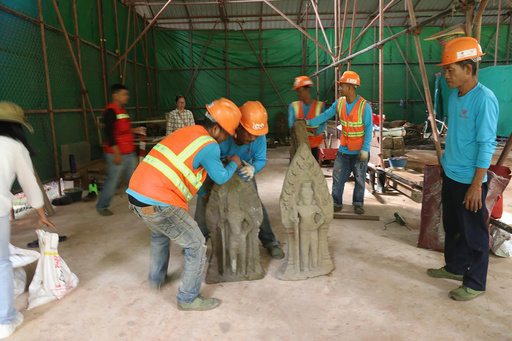
PHNOM PENH, Cambodia — In a significant archaeological find, experts in Cambodia have uncovered a dozen ancient sandstone statues at the renowned Angkor World Heritage Site, located near Siem Reap. This discovery was reported by authorities on Wednesday.
The statues, featuring figures known as “door guardians,” were located last week adjacent to the northern gate that leads to the 11th-century Royal Palace at Angkor Thom, which was the final capital of the Khmer Empire. Long Kosal, the spokesperson for the Apsara National Authority— the governing body responsible for the archaeological park— shared these details.
During the inspection of the gate’s structure and the search for any fallen stones near the north portal of Angkor Thom, which is one of the four main entrances to the complex, the archaeologists stumbled upon the remarkable statues.
These statues, standing at attention, vary in height between approximately 1 meter and 110 centimeters (around 39 to 43 inches). They were discovered buried at depths of up to 1.4 meters (4.5 feet), and many of them are in surprisingly good condition. Each statue showcases unique facial hair ornaments, enhancing their individuality, as noted by archaeologist Sorn Chanthorn.
Experts believe these door guardians embody the Khneang Style, correlating with the construction period of the Royal Palace from the 11th century, according to the Apsara National Authority.
Angkor Thom is part of the expansive Angkor Archaeological Park, which covers about 400 square kilometers (approximately 155 square miles). This site was designated a UNESCO World Heritage Site in 1992 and is among the most frequented tourist attractions in Southeast Asia. It houses the remnants of Khmer Empire capitals that date from the 9th to the 15th centuries, including the acclaimed temple of Angkor Wat.
Located about 200 miles (320 kilometers) northwest of the national capital, Phnom Penh, Angkor drew more than 500,000 international tourists in the first half of 2024, per data from Cambodia’s Tourism Ministry.
The archaeological excavation was a joint initiative between Apsara and the China-Cambodia Government Team for Safeguarding Angkor. Following the discovery of these statues, the team meticulously recorded their locations before carefully removing them for cleaning and restoration. Plans are in place for the statues to be returned to their original sites once the restoration is complete.
Many cultural artifacts from the Khmer era have been lost due to extensive looting that occurred during the civil unrest and the oppressive rule of the Khmer Rouge regime in the 1970s. In recent years, Cambodia has seen an encouraging trend of returning stolen art and archaeological items, with August marking a celebratory moment as dozens of artifacts were returned from international museums and private collections.
However, the country has faced backlash regarding its efforts to maintain the integrity of the Angkor site, which has included relocating thousands of families. This has been criticized by Amnesty International as a severe violation of human rights.
In response to ongoing concerns, the U.N.’s World Heritage Committee, during its July meeting, recommended that Cambodia seek the expertise of a new team to oversee the situation at the site.
